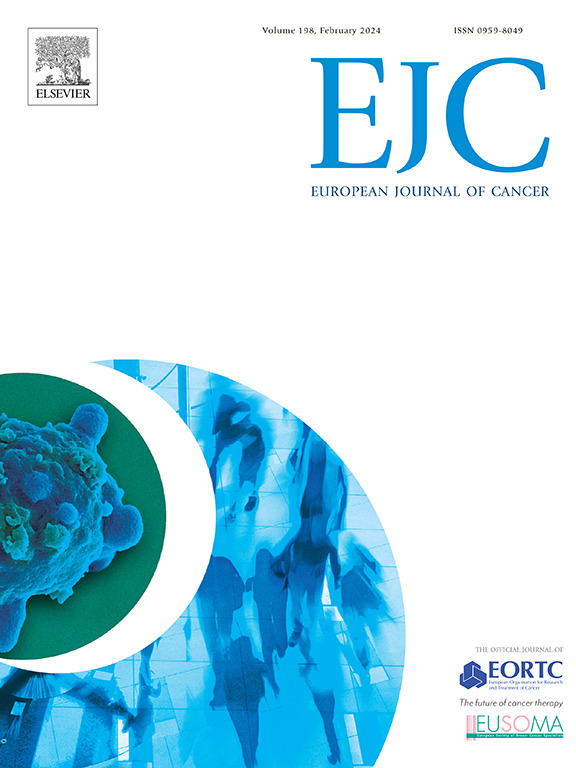放射学无进展生存期作为转移性激素敏感前列腺癌患者总生存期的替代指标:一项双变量荟萃分析
IF 7.6
1区 医学
Q1 ONCOLOGY
引用次数: 0
摘要
背景:总生存期(OS)是各种实体瘤试验的标准疗效终点;然而,与潜在的中间终点相比,需要更长的随访时间进行评估。本研究使用随机对照试验(rct)的总体数据,评估了转移性激素敏感性前列腺癌(mHSPC)的放射无进展生存期(rPFS)作为OS的替代指标。方法系统文献回顾了截至2023年12月发表的mHSPC随机对照试验,报告了rPFS (HRrPFS)和OS (HROS)的风险比。采用双变量随机效应荟萃分析(BRMA)评估HRrPFS和HROS之间的相关性。采用留一交叉验证(LOOCV)评估预测效度。替代阈值效应(STE),或最小rPFS获益预测OS获益,使用最近的mHSPC试验样本量进行估计。敏感性分析(1)省略了只报告了一个终点的试验,(2)省略了违反比例风险假设的hr,(3)省略了允许交叉的试验,(4)调查了研究内相关性的不同假设值。结果初步分析包括31项试验的35个治疗比较。rPFS-OS相关性为0.95(95 % CrI: 0.75, 1.00)。LOOCV证实HROS在95% %的预测区间内。根据预测的试验规模,估计STE范围为0.55至0.71。敏感性分析产生了较强但略低的相关性(0.87,0.89,0.91),在交叉验证中完全覆盖了报告的HROS。研究内相关性的增加略微降低了研究间相关性。得出的替代方程可以根据mHSPC报告的rPFS益处进行OS估计,满足NICE的95% %替代效度阈值。这些发现支持rPFS作为OS的可靠替代品,有助于预测未来mHSPC试验中OS的益处。本文章由计算机程序翻译,如有差异,请以英文原文为准。
Radiological progression-free survival as a surrogate for overall survival in patients with metastatic hormone-sensitive prostate cancer: A bivariate meta-analysis
Background
Overall survival (OS) is the standard efficacy endpoint in various solid tumor trials; however, it requires longer follow-up time for assessment than potential intermediate endpoints. This study evaluated radiological progression-free survival (rPFS) as a surrogate for OS in metastatic hormone-sensitive prostate cancer (mHSPC) using aggregate-level data from randomized controlled trials (RCTs).
Methods
A systematic literature review identified mHSPC RCTs published through December 2023, reporting hazard ratios for rPFS (HRrPFS) and OS (HROS). Correlation between HRrPFS and HROS was assessed using bivariate random-effects meta-analysis (BRMA). Predictive validity was assessed with leave-one-out cross-validation (LOOCV). The surrogate threshold effect (STE), or minimum rPFS benefit predicting an OS benefit, was estimated using recent mHSPC trial sample sizes. Sensitivity analyses (1) omitted trials that had only one of the endpoints reported, (2) omitted HRs that violated proportional hazards assumptions, (3) omitted trials that allowed cross-over and (4) investigated different assumed values of the within-study correlation.
Results
The primary analysis included 35 treatment comparisons from 31 trials. The estimated rPFS-OS correlation was 0.95 (95 % CrI: 0.75, 1.00). LOOCV confirmed HROS were within 95 % prediction intervals. The estimated STE ranged from 0.55 to 0.71 depending on the trial size being predicted. Sensitivity analyses produced strong but slightly lower correlations (0.87, 0.89, 0.91) than the primary analysis, with full coverage of the reported HROS in cross validation. Increasing within-study correlation slightly reduced between-study correlation.
Conclusions
The derived surrogacy equation enables OS estimation based on reported rPFS benefits in mHSPC, meeting NICE’s 95 % surrogate validity threshold. These findings support rPFS as a reliable surrogate for OS, facilitating prediction of OS benefits in future mHSPC trials.
求助全文
通过发布文献求助,成功后即可免费获取论文全文。
去求助
来源期刊

European Journal of Cancer
医学-肿瘤学
CiteScore
11.50
自引率
4.80%
发文量
953
审稿时长
23 days
期刊介绍:
The European Journal of Cancer (EJC) serves as a comprehensive platform integrating preclinical, digital, translational, and clinical research across the spectrum of cancer. From epidemiology, carcinogenesis, and biology to groundbreaking innovations in cancer treatment and patient care, the journal covers a wide array of topics. We publish original research, reviews, previews, editorial comments, and correspondence, fostering dialogue and advancement in the fight against cancer. Join us in our mission to drive progress and improve outcomes in cancer research and patient care.
 求助内容:
求助内容: 应助结果提醒方式:
应助结果提醒方式:


